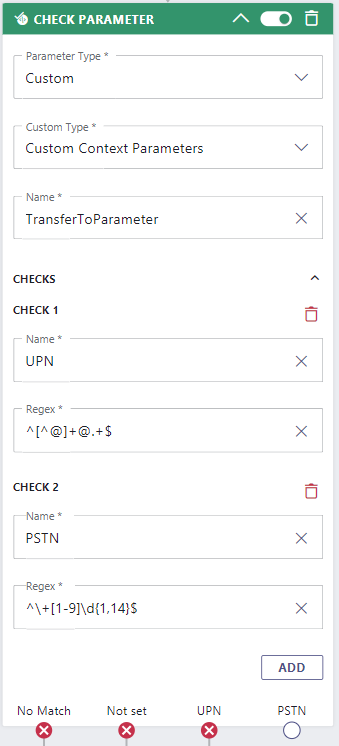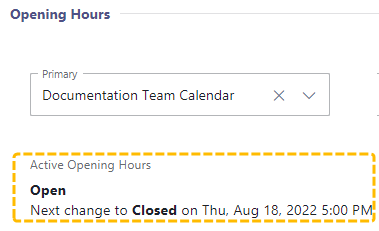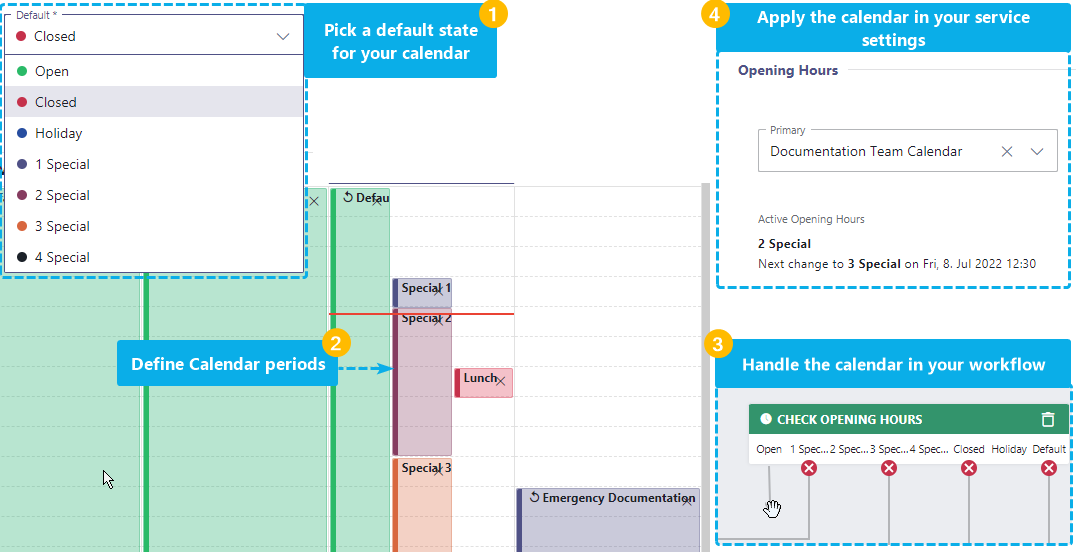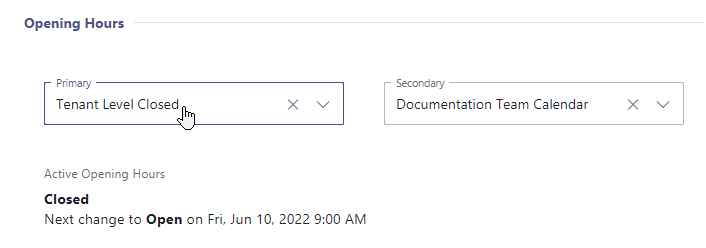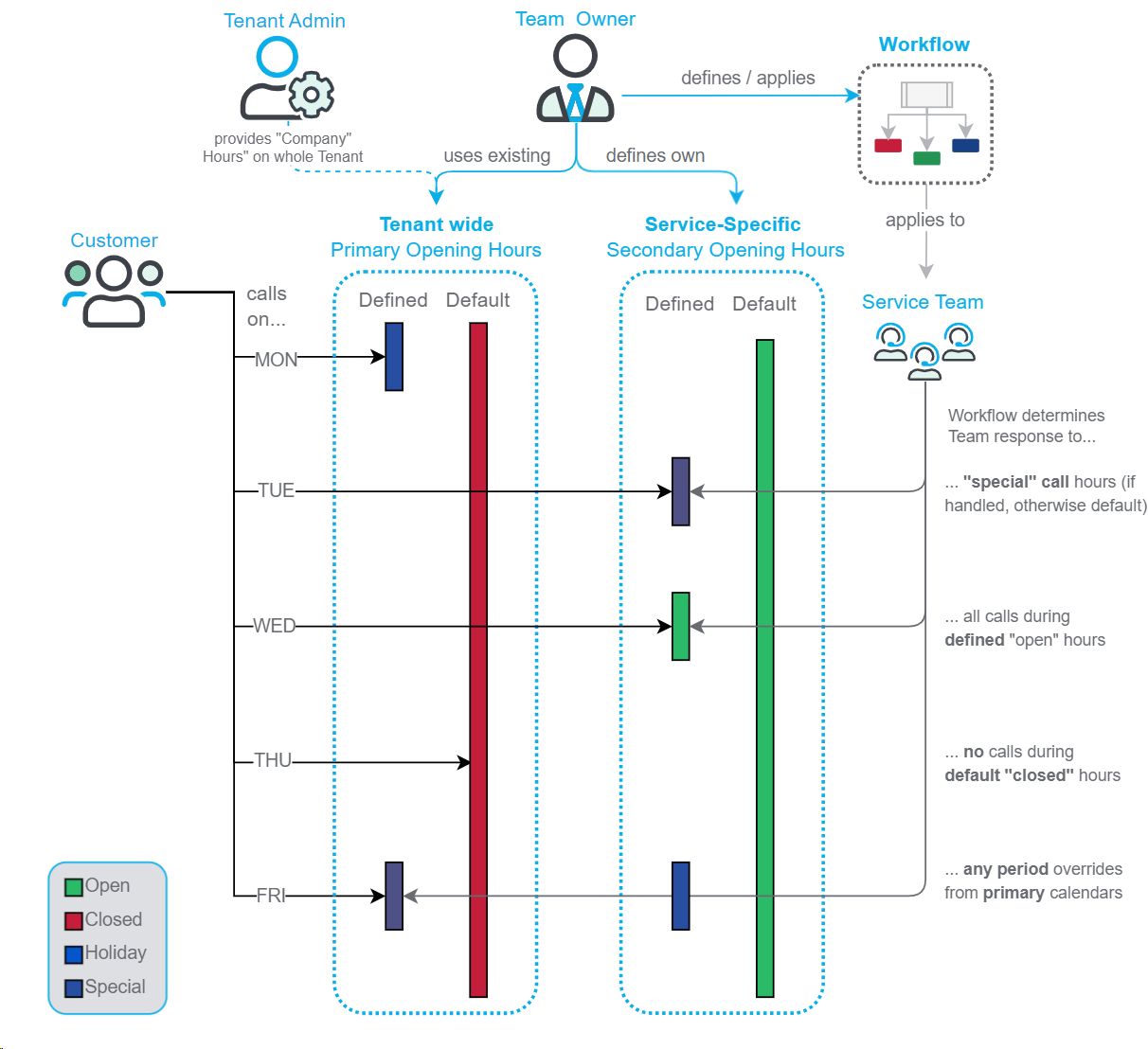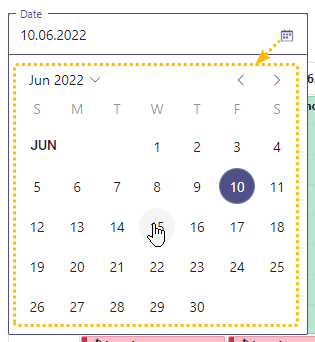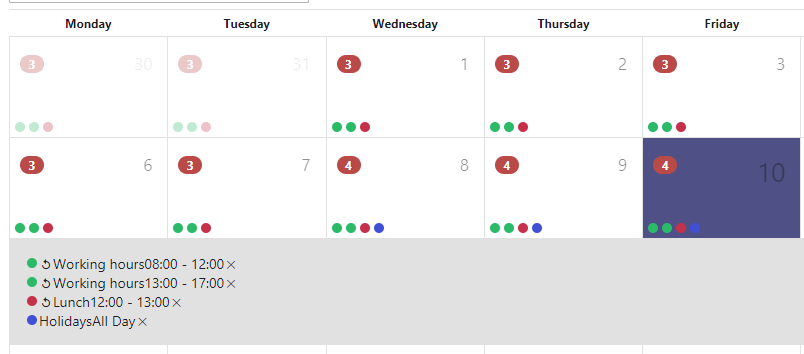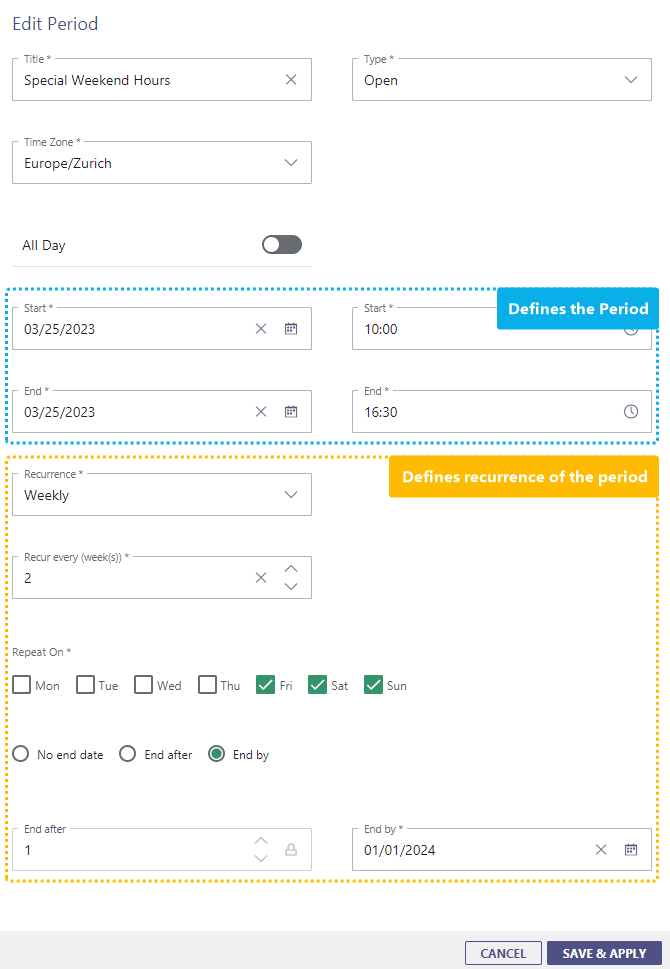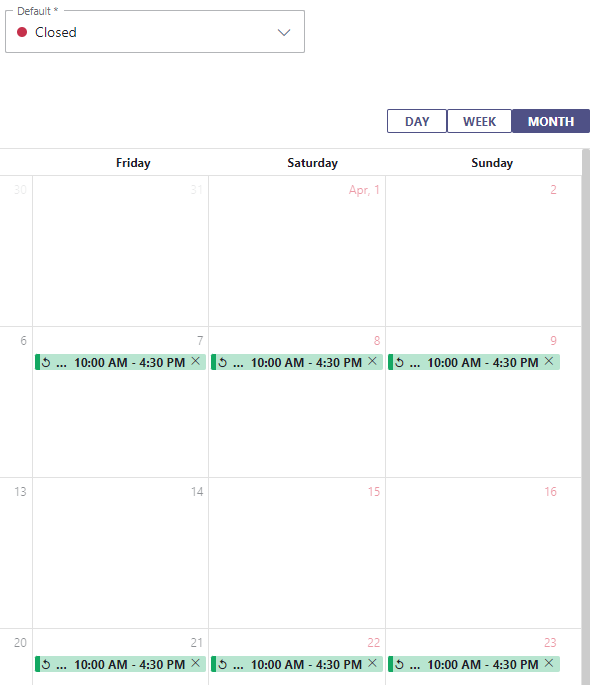🔎New to workflows? Read the following!
The following page will list all workflow activities and their configurable properties. Please note:
- Terminology: "Workflow Step", "Workflow Element" and "Workflow Activity" are used synonymously.
- Certain workflow activities are retricted by license / and modality. See Nimbus Features for a comparison. A License Downgrade may not be performed until you remove the according activities from your workflows.
- Certain workflow activities have required predecessors - ensure to have them connected in your workflow to avoid errors in call handling.
-
All workflows heavily rely on prepared Configuration data entities
- Common examples are: Opening Hours, Parameters, Playlists and Resources (Audio files).
- Make sure to configure these entities beforehand and structure them into Organization Units accessible to your workflow.
-
Activities with Text-to-Speech (TTS) generators use engines provided by Microsoft.
- We dynamically update the list of available languages. Any old or outdated selections may therefore be marked with a warning that disappears until you select a different TTS-engine.
- Your existing "outdated" TTS-activities still remain intact as a working copy on the Nimbus infrastructure until you change them.
🔎Changed licenses recently? Learn about activity availability here!
This workflow activity list below shows license dependencies and is an excerpt from the Nimbus Features Matrix. Note that the Workflow Editor will list all activities, ignoring any license constraints. However, you may not apply workflows (in Modalities Service Settings) that use such activities if your service isn't licensed for it. Accordingly – when you perform a License Downgrade you must remove those activities which require a specific license.
INC Workflow Activity License Matrix
 |
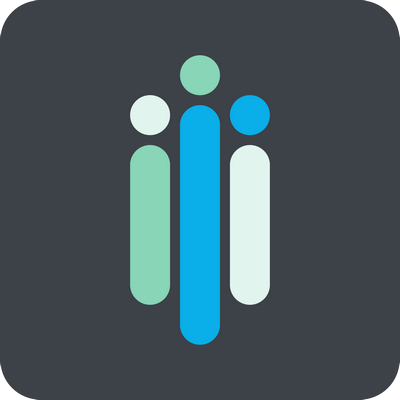 |
 |
|
|---|---|---|---|
Service License |
Advanced Routing |
Enterprise Routing |
Contact Center |
| Workflow Activities | |||
| Accept | ✅ | ✅ | ✅ |
| Add Virtual User1 | ⬜ |
✅ |
✅ |
| Announcement | ✅ | ✅ | ✅ |
| Availability-based Routing | ✅ | ✅ | ✅ |
| Cancel Task | ⬜ | ✅ | ✅ |
| Check Opening Hours | ✅ | ✅ | ✅ |
| Check Parameter (Parameter-based Routing) | ⬜ | ✅ | ✅ |
| Check Task | ⬜ | ✅ | ✅ |
| Collect Information | ⬜ | ✅ | ✅ |
| Delay | ⬜ |
⬜ |
✅ |
| Disconnect | ✅ | ✅ | ✅ |
| Disconnect as Handled (Email) | ⬜ |
⬜ |
✅ |
| Distribution Priority (set Task Priority) | ⬜ |
⬜ |
✅ |
| Get Available Users | ⬜ | ✅ | ✅ |
| Get Queue Position | ⬜ | ✅ | ✅ |
| Input Customer (IVR) | ✅ | ✅ | ✅ |
| Input Customer Advanced | ⬜ | ✅ | ✅ |
| Mark as Handled | ⬜ |
⬜ |
✅ |
| Message | ⬜ |
⬜ |
✅ |
| Origin Routing | ✅ | ✅ | ✅ |
| Play Music | ✅ | ✅ | ✅ |
| Queue | ✅ | ✅ | ✅ |
| Queue Task | ⬜ | ✅ | ✅ |
| Reply | ⬜ |
⬜ |
✅ |
| Save to Parameter | ⬜ | ✅ | ✅ |
| Standby Duty | ⬜ | ✅ | ✅ |
| Transfer | ✅ | ✅ | ✅ |
| Voice Message | ✅ | ✅ | ⬜ |
| Wait for Parameter (e.g. external updates) | ⬜ | ✅ | ✅ |
| Web Request | ⬜ | ✅ | ✅ |
| Call Distribution modes within “Queue / Queue Task” activity | |||
| Broadcast | ✅ | ✅ | ✅ |
| Pickup2 | ⬜ | ✅ | ⬜ |
| Direct | ✅ | ✅ | ✅ |
| Features related to Workflows | |||
| Basic Call Templates | ✅ | ✅ | ✅ |
| IVR Transfer Templates | ✅ | ✅ | ✅ |
| Configurable Opening Hours | ✅ | ✅ | ✅ |
1 Requires an extra license to be applied. Refer to Virtual Users configuration or your License Management.
2 Pickup controls can be shared in a Teams Channel context using Adaptive Cards. They are exclusive to Services with MS Teams-based User Assignment. In a Contact Center context, this approach is replaced with Distribution Policies that automate the distribution to individually managed Users (Agents).
List of Workflow Activities
Tabs below contain a list of all workflow activities. If you need to consume this content in smaller size, head to the respective subpages:
Conversation Handling
Conversation Handling Activities
This page lists all Workflow activities that relate to customer interaction, e.g. by informing the customer via text message, resource audio files, receiving input via IVR, storage of data in Parameters, or transferring an existing interaction.
💡Note that activities below are listed in alphabetical order, which is not necessarily the order of their intended use.
Accept
Accept
 Accept
Accept
| Description | Accepts an incoming task (of any modality) and establishes the corresponding communication channel between caller and user. | |||||||
| Required Predecessor | Essential: Disconnect AND Accept in a Workflow☝ This activity is essential and cannot be disabled.
1 LIMITATION: Microsoft will wait for 15 seconds for a Nimbus answer triggered by the Accept activity. ⮑ After that the task will fail. ⮑ Note that during this time, the call will still ring for the customer. ⮑ As Nimbus cannot control how long external systems need to recover data (e.g. via Nimbus Power Automate Connector) we recommend smaller routines for checking essential parameters. Afterwards you can Accept and handle further checks during a customer announcement or IVR. |
|||||||
| License |
|
|||||||
| Modalities | Audio / Video | Instant Messaging | External Task | |||||
Common Properties
| Configurable Properties | Description |
|---|---|
| None | Controls when your task will be marked as “Accepted by System” in a Nimbus Reporting session, both for the Nimbus Reporting Model and later KPI evaluation purposes in the Nimbus Power BI Template. 🔎 This activity is part of the Trigger Events in the Nimbus Power Automate Connector. |
Audio / Video
INC WF Properties remark
No specific behaviors for this modality. “Common Properties” apply.
Instant Messaging
INC WF Properties remark
No specific behaviors for this modality. “Common Properties” apply.
INC WF Properties remark
No specific behaviors for this modality. “Common Properties” apply.
External Task
INC WF Properties remark
No specific behaviors for this modality. “Common Properties” apply.
Add Virtual User
Add Virtual User
 Add Virtual User
Add Virtual User
INC Beta Feature

This feature is in PREVIEW and may not yet be available to all customers. Functionality, scope and design may change considerably.
| Description |
Adds a preconfigured Virtual User (AI Bot) to engage with the Customer. 💡The Virtual User will behave according to the prompts in its configuration and use external APIs, as defined in Nimbus Configuration > Bots. |
||||||
| Required Predecessor | Accept | ||||||
| License |
|
||||||
| Modalities | Audio / Video | Instant Messaging | External Task | ||||
Common Properties
| Configurable Properties | Description |
|---|---|
| Virtual User |
✅ Requires a Virtual User item with “Virtual User” License applied to be ready for processing Customer inputs. Refer to Use Case - Setting up a Nimbus Virtual User using Copilot. ☝Note: Productive workflows may be affected by (missing) licensing While no license is applied to a Virtual User, the “Failed” exit is taken automatically. |
|
Max Input Timeout hh:mm:ss (default 00:01:00) |
Maximum wait time for any Customer Response
💡 If no interaction occurred between Customer and Bot, the "Idle Timeout" exit node is used. |
| Text to Speech |
Uses Microsoft Text-to-Speech routines to convert the bot response into audio for the Customer. 💡Note that the configuration of your Virtual User (e.g. “Topics” within Copilot Studio) determine how long these audio replies can get. We advise to give the bot instructions to limit itself to a maximum of 2-3 sentences. |
| Exits |
Exits:
|
Additional Notes:
Caller Sentiment and Intent: Bot activity also stores and updates System Fields and Parameters > CallData:
| Name | Type | Lifecycle | Placeholder | UIName |
|---|---|---|---|---|
| CallerSentiment | String | Customer Session | $(Caller.Sentiment) |
Customer Sentiment |
| CallerIntent | String | Customer Session | $(Caller.Intent) |
Customer Intent |
☝Potentially blank fields: If the underlying Bot behind your Virtual User activity does not support Sentiment / Intent analysis – or is not not configured for it – these fields will be left blank during a Session.
INC Azure Billing Cognitive Services
Disclaimer: Support for Azure Billing & Cognitive Services
☝ The usage of Microsoft Azure AI Services for Speech1 and AI2 will cause additional costs outside your Nimbus subscription, which are exclusively determined by Microsoft.
Please note:
- Nimbus Support does not cover pricing discussions or make recommendations on Microsoft Azure Services. → Please inform yourself via the references below on pricing models.
- Nimbus Support can not provide any technical help, insights or solutions on Azure Cognitive Service related technical problems.
1 Azure Speech Services: https://azure.microsoft.com/en-us/pricing/details/cognitive-services/speech-services/
2 Generative AI Services (Copilot Studio):
Audio / Video
INC WF Properties remark
No specific behaviors for this modality. “Common Properties” apply.
Announcement
Announcement
 Announcement
Announcement
| Description |
Plays a defined resource or text to the caller. Can generate text to speech "on-the-fly". INC Fair Use Disclaimer🤝 This feature uses runtime resources under a fair-use policy. Luware may change the usage limit or contact customers that exceed the general usage quota. |
||||||
| Required Predecessor | Accept | ||||||
| License |
|
||||||
| Modalities | Audio / Video | Instant Messaging | External Task | ||||
Common Properties
| Configurable Properties | Description |
|---|---|
| Announcement Type |
🔍 Audio resources can be added via Configuration > Resources . |
|
Add Parameters ( Toggle ) |
Will allow the use of Custom Parameters and System Fields and Parameters in the "Prompt Text" Field. 💡 Note that with this option enabled the will "Preplay" feature is disabled as paramaters are dynamically resolved during a call. |
| Prompt Language | Allows to select the locale / voice to use when using the Text-to-Speech engine. |
| Prompt Text | ✅ Only shown when Announcement Type = Text to Speech is selected.
USAGE AND LUWARE FAIR USE POLICYThis activity has a dynamic character limit for the Text-To-Speech engine. The final resolved parameter values – not the name of your Parameters – count towards this character limit. Keep this in mind when parameters are very long (e.g. a customer with multiple surnames). 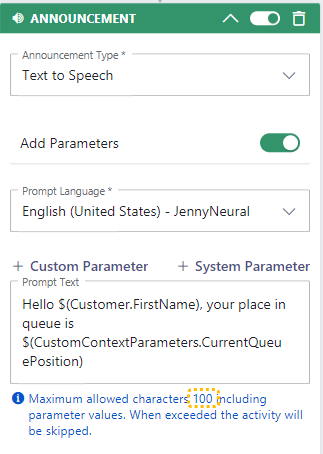 ☝ Note: When the limit is exceeded, this activity will be skipped. → We recommend splitting the important information (e.g. parameters) into separate "Announcement" activities with short sentences each to avoid a skip. |
Audio / Video
INC WF Properties remark
No specific behaviors for this modality. “Common Properties” apply.
Collect Information
Collect Information
 Collect Information
Collect Information
| Description | Allows to store DTMF inputs in Parameters, exiting based on whether or not an input was received. The parameter can also be used in other areas and verified via the "Check Parameter" activity. | ||||||
| Required Predecessor | Accept | ||||||
| License |
|
||||||
| Modalities | Audio / Video | Instant Messaging | External Task | ||||
Common Properties
| Configurable Properties | Description |
||||||||||
|---|---|---|---|---|---|---|---|---|---|---|---|
| Prompt Type |
🔍 Audio resources can be added via Configuration > Resources . |
||||||||||
| Prompt Language | Allows to select the locale / voice to use when using the Text-to-Speech engine. | ||||||||||
| Prompt Text |
✅ Only shown when "Prompt Type" = Text to Speech is selected. Allows you to add text that will be read in the prompt language / locale. |
||||||||||
|
Input during announcement ( barge in ) |
Defines when the caller is allowed to enter input:
💡 When enabled, the "Time to complete started input" timer starts immediately upon first input. Any prompts at this point are stopped. |
||||||||||
| Parameter To Save | ✅ Required: To be visible in this selection menu at least one Custom Parameter must be defined and made available to your service or tenant-wide via Organization Unit configuration.
Parameters can be used in the following areas:
|
||||||||||
|
Input Timeout hh:mm:ss |
Defines the maximum time in which a caller can enter and complete the input:
|
||||||||||
|
Max DTMF Digits (default: 1, min:1, max 999) |
Defines the maximum of DTMF tone digits. The collection will be stopped automatically if the defined maximum is reached and the input is stored. 🔍 Further exit conditions may apply, see "Node Exits" description below. |
||||||||||
| Node Exits | The "input received" activity exit is taken under the following conditions:
In all cases the parameter is stored and the default / previous parameter is overridden. ACCOUNT FOR PARAMETER PROCESSING DELAYSA common use case is to add a "Check Parameter" activity right after your "Collect Information":
Recommendation: When involving an external system (e.g. using the Microsoft Power Automate Connector ), add an "Announcement" or other delaying workflow activity that allows "Check Parameter" to catch the updated return value. |
Audio / Video
INC WF Properties remark
No specific behaviors for this modality. “Common Properties” apply.
Instant Messaging
💡Customer data visibility: During an ongoing Instant Messaging session, any messages that customer enters into the chat will be visible to the Nimbus user, including information entered during the “Collect Information” activity input duration.
| Configurable Properties | Description |
|---|---|
| Prompt Type | Not applicable. |
| Prompt Language | Not applicable. |
| Prompt Text | Multi Line Text Box with Custom Parameters and System Fields and Parameters support. |
|
Input during announcement ( barge in ) |
Not applicable. |
| Parameter To Save | INC WF Properties remarkNo specific behaviors for this modality. “Common Properties” apply. |
|
Input Timeout hh:mm:ss |
INC WF Properties remarkNo specific behaviors for this modality. “Common Properties” apply. |
|
Max DTMF Digits (default: 1, min:1, max 999) |
Not applicable. |
| Node Exits | 💡 There is no input validation.
|
Delay
Delay
 Delay
Delay
| Description |
Adds a delay into the workflow so that external processes (like Power Automate flow runs) have enough time to complete. 💡Tip: Note that this activity that will not abort when an external system responds. If you need a more precise timing, consider using the “Wait for Parameter” activity or use “Check Parameter” in a loop with smaller “Delays” in between. |
||||||
| Required Predecessor | Accept | ||||||
| License |
|
||||||
| Modalities | Audio / Video | Instant Messaging | External Task | ||||
Common Properties
| Configurable Properties | Description |
|---|---|
|
Delay Time hh:mm:ss |
When the activity is reached, wait for the specified time.
|
Instant Messaging
INC WF Properties remark
No specific behaviors for this modality. “Common Properties” apply.
INC WF Properties remark
No specific behaviors for this modality. “Common Properties” apply.
External Task
INC WF Properties remark
No specific behaviors for this modality. “Common Properties” apply.
Disconnect
Disconnect
 Disconnect
Disconnect
| Description | Terminates an incoming task or disconnects an already accepted task (of any modality). | ||||||
| Required Predecessor | Essential: Disconnect AND Accept in a Workflow☝ This activity is essential and cannot be disabled.
|
||||||
| License |
|
||||||
| Modalities | Audio / Video | Instant Messaging | External Task | ||||
Common Properties
| Configurable Properties | Description |
|---|---|
| None | Acts as end node to terminate the call. Controls when your task will be marked as “Workflow Disconnect” in the reporting session, both for Nimbus Reporting Model and KPI evaluation purposes.
🔎 This activity is part of the Trigger Events in the Nimbus Power Automate Connector. |
Audio / Video
INC WF Properties remark
No specific behaviors for this modality. “Common Properties” apply.
Instant Messaging
INC WF Properties remark
No specific behaviors for this modality. “Common Properties” apply.
INC WF Properties remark
No specific behaviors for this modality. “Common Properties” apply.
External Task
INC WF Properties remark
No specific behaviors for this modality. “Common Properties” apply.
Disconnect as Handled
Disconnect as Handled
 Disconnect as Handled
Disconnect as Handled
| Description |
When this activity succeeded it will mark the task “Handled” for Reporting. ✅ How to use:
|
||||||
| Required Predecessor | Accept | ||||||
| License |
|
||||||
| Modalities | Audio / Video | Instant Messaging | External Task | ||||
| Configurable Properties | Description |
|---|---|
| None |
Activity behavior
🤔Why is “Disconnect” still necessary? If moving a “handled” Email fails for any reason, a “Disconnect” covers the failure state and helps to quickly identify all mails related to a problem. 🔎 Reporting effects: This activity has the same task-concluding effect if a user is clicking “Marked as Handled” in Nimbus My Sessions UI. However, the Nimbus Reporting Model outcome will differ:
|
Input Customer
Input Customer
 Input Customer (IVR)
Input Customer (IVR)
| Description |
Plays / Shows a prompt while allowing the caller to perform DTMF and chat inputs. ☝ Please NoteThis action uses up to 10 exit nodes to react to customer input. When the corresponding prompt properties are not filled out, saving is not possible. |
||||||
| Required Predecessor | Accept | ||||||
| License |
|
||||||
| Modalities | Audio / Video | Instant Messaging | External Task | ||||
Common Properties
💡 Some of the fields/properties are only shown when the corresponding option is toggled on.
| Configurable Properties | Description |
|---|---|
| Main Prompt Type |
🔍 Audio resources can be added via Configuration > Resources. |
| Prompt Language | Allows to select the locale / voice to use when using the Text-to-Speech engine. |
| Prompt Text | Allows you to add text that will be read in the prompt language / locale. |
|
Input during announcement ( barge in ) |
When enabled:
When disabled:
|
|
Max Input Timeout ( toggle ) |
Enables a maximum wait time to be specified in field below. |
|
Max Input Timeout hh:mm:ss (default 00:00:30) |
Maximum wait time for any caller response to be started.
💡 Once started the "Time to complete started input" field applies (not supported by Instant Messaging). 💡 If nothing was entered, the "No Recognition (NR)" exit node is used. |
|
Time to complete started input hh:mm:ss (min 00:00:01, max 00:00:09) |
Specifies the time the caller has to complete the next input. |
| Expected Input | Description |
| Name | A clear name for the exit node. ✅ You can add up to 10 nodes by clicking "Add Input" at the end this field group. |
| DTMF |
Allows to enter multiple DTMF tones / digits per exit node. 🔍 If a user hasn't entered all expected digits yet – or the input is ambiguous (expected input 1: 123, input 2: 12, the caller enters "12") – the "Time to complete started input" applies before the DTMF is evaluated. 🔍 Unexpected key combinations are marked as as unclear and escalated with a “Wrong Input” prompt. |
| Missing Input | Description |
|
Timeout hh:mm:ss (default 00:00:10) |
Time for the caller to enter input. Afterwards the 1st prompt is played. |
1st Prompt |
Message to play when the input was not occurring in the timeout. A selection of the following options:
🔍 Audio resources can be added via Configuration > Resources . If User enters no input within the silence timeout:
|
| Wrong Input | Description |
1st Prompt |
Message to play when the input was not recognized. A selection of the following options:
🔍 Audio resources can be added via Configuration > Resources . If User enters a wrong input:
|
Input Limitation
It is not possible for the caller to use the hash symbol (#) when entering input.
Manual Replacement of Input Customer with Input Customer (Advanced)
By right-clicking on the Input Customer workflow activity, you can replace it with Input Customer (Advanced):

💡 This only works in case the workflow doesn't have a workflow template with workflow or structure lock.
When replacing Input Customer with Input Customer (Advanced), all connections (entries and exits) and all values from all properties are preserved.
💡 It is currently not possible to downgrade from Input Customer (Advanced) to Input Customer.
Audio / Video
INC WF Properties remark
No specific behaviors for this modality. “Common Properties” apply.
Instant Messaging
| Configurable Properties | Description |
|---|---|
| Main Prompt Type | Not applicable. |
| Prompt Language | Not applicable. |
| Prompt Text | Not applicable. |
|
Input during announcement ( barge in ) |
Not applicable. |
|
Max Input Timeout ( toggle ) |
Enables a maximum wait time to be specified in field below. |
|
Max Input Timeout hh:mm:ss (default 00:00:30) |
Maximum wait time for any chat response. The time of message receive applies:
💡 Once started the "Time to complete started input" field applies. 💡 If nothing was entered, the "No Recognition (NR)" exit node is used. |
|
Time to complete started input hh:mm:ss (min 00:00:01, max 00:00:09) |
Not applicable. |
| Expected Input | Description |
| Name |
A clear name for the exit node. ✅ You can add up to 10 nodes by clicking "Add Input" at the end this field group. |
| Input | Multi Line Text Box with Custom Parameters and System Fields and Parameters support.
💡 Example: A customer secret is taken from a CRM and expected as an input from the customer to verify. Refer to Power Automate Use Case for examples on data retrieval.
☝ Limitation: When the customer is chatting very fast, it could be that the "Input Customer" activity catches and evaluates the wrong input. We recommend to loop the NR (not recongized) exit on an extra "Chat" message, then back to the activity itself. |
| Missing Input | Description |
|
Timeout hh:mm:ss (default 00:00:10) |
Time for the chat. Afterwards the 1st prompt is played.
|
1st Prompt |
Multi Line Text Box with Custom Parameters and System Fields and Parameters support. If User enters no input within the timeout:
|
| Wrong Input | Description |
1st Prompt |
Multi Line Text Box with Custom Parameters and System Fields and Parameters support. If User enters a wrong input:
|
Input Customer (Advanced)
Input Customer (Advanced)
 Input Customer (Advanced) (IVR)
Input Customer (Advanced) (IVR)
| Description |
Plays/shows a prompt while allowing the caller to perform voice and DTMF input. ☝ Please NoteThis action uses up to 10 exit nodes to react to customer input. When the corresponding prompt properties are not filled out, saving is not possible. PRECONDITIONS FOR VOICE INPUTYou need to add and configure a Speech Recognizers (needed for voice analysis) first in order to use the voice input functionality. |
|||||
| Required Predecessor | Accept | |||||
| License |
|
|||||
| Modalities | Audio/Video | Instant Messaging | External Task | |||
Properties
💡 Some of the fields/properties are only shown when the corresponding option is toggled on.
| Configurable Properties | Description |
|---|---|
| Main Prompt Type |
🔍 Audio resources can be added via Configuration > Resources. |
| Prompt Language | Allows to select the locale/voice to use when using the Text-to-Speech engine. |
| Prompt Text |
Allows you to add text that will be read in the prompt language/locale. To make use of the functionality, Add Parameters need to be enabled first. Once enabled, you can add custom and system parameters to your prompt text, e.g.: |
|
Max Input Timeout hh:mm:ss |
Maximum wait time for any caller response to be started.
💡 Once started, the “Time to complete started voice input” / “Time to complete started DTMF input” field applies. 💡 If nothing was entered, the "No Recognition (NR)" exit node is used.
|
| Max Number Retries Enabled (toggle) |
If enabled, a maximum number for retries can be defined.
If a maximum number “x” of retries is set, the NR exit is taken if one of the follow scenarios apply:
Missing/wrong input are treated as described further down in the table. |
| Voice Recognition (toggle) | Allows text-to-speech input for the customer when toggled on. |
|
Time to complete started voice input hh:mm:ss |
Specifies the time the caller has to make the voice input.
|
| Speech Recognizer |
The speech recognizer used for voice input processing. 🔍 Speech Recognizers can be added and configured via Configuration > Virtual Assistants > Speech Recognizers. |
| DTMF (toggle) | Allows DTMF input for the customer when toggled on. |
|
Time to complete started DTMF input hh:mm:ss |
Specifies the time the caller has to complete the next DTMF input.
|
|
Input during announcement (barge in) |
When enabled:
When disabled:
Voice Input: Limitation by MicrosoftBarging in (using voice input during announcement) is currently not possible. This is a limitation from Microsoft and there is currently no workaround. |
| Parameter to Save |
Allows to store the customer's input (voice input or DTMF) to a custom parameter for further usage.
|
| Save on No Recognition |
Will store customer inputs in a custom Parameter even if the No Recognition (NR) exit is taken.
General Limitation on voice inputsIf there is a silence on the caller's end, any noise recorded might still be considered as a “wrong” or “missing” input. This is a design limitation that can be caused by the static noise or phone system shortcomings outside of Nimbus control. ☝ For your later parameter validation within workflows, keep in mind that checking this option will override the parameter default value with anything that was picked up. → If you regularly encounter issues with erroneous customer inputs, we recommend using the Nimbus Power Automate Connector to store customer inputs to be later checked by an Agent / Supervisor, e.g. by showing the parameter in My Sessions or storing it in a list for later workflow improvements. |
| Expected Input | Description |
| Name | A clear name for the exit node. ✅ You can add up to 10 nodes by clicking "Add Input" at the end this field group. |
| DTMF |
Allows to enter multiple DTMF tones/digits per exit node. 🔍 If a user hasn't entered all expected digits yet – or the input is ambiguous (expected input 1: 123, input 2: 12, the caller enters "12") – the "Time to complete started input" applies before the DTMF is evaluated. 🔍 Unexpected key combinations are marked as as unclear and escalated with a “Wrong Input” prompt. |
| Voice Input |
The voice input to be made by the customer. ☝ Only single words are matched in expected input validation. → You can configure multiple expected keywords by providing a comma-separated list of keywords per exit. Best Practice: Handling numerical voice inputsFrom the Microsoft Speech-To-Text documentation:
💡The Microsoft Speech-To-Text engine interprets spoken words in a fixed manner, meaning that you might not get an expected input “1” if the customer says “One”, you best handle all possibilities as one expected input list, e.g. “1, One”.
💡When your Speech-Recognizer is set to be Multilingual, you need to cover those variants as a list, e.g. “Eins, Uno, One”.
|
| Missing Input | Description |
|
Timeout hh:mm:ss |
Time for the caller to enter input. Afterwards the 1st prompt is played.
💡 Note: For voice input, the maximum recording time is timeout -3 seconds. The system needs this time to process and analyze the input. |
|
1st Prompt 2nd Prompt |
Message to play when the input was not occurring in the timeout. A selection of the following options:
🔍 Audio resources can be added via Configuration > Resources . If User enters no input within the silence timeout:
|
| Wrong Input | Description |
1st Prompt |
Message to play when the input was not recognized. A selection of the following options:
🔍 Audio resources can be added via Configuration > Resources . If User enters a wrong input:
|
Input Limitation
- Voice input via PSTN call - Silence detection is currently not working for voice input when the calling from a PSTN. In this case, the maximum recording time is recorded. The maximum recording time is calculated as follows: missing input timeout -3 seconds (this time is needed to process and analyze the recording). Note that this is a limitation by Microsoft and there is currently no more optimal workaround possible.
- DTMF input - It is not possible for the caller to use the hash symbol (#) when entering DTMF input.
Manual Replacement of Input Customer with Input Customer (Advanced)
By right-clicking on the Input Customer workflow activity, you can replace it with Input Customer (Advanced):

💡 This only works in case the workflow doesn't have a workflow template with workflow or structure lock.
When replacing Input Customer with Input Customer (Advanced), all connections (entries and exits) and all values from all properties are preserved.
💡 It is currently not possible to downgrade from Input Customer (Advanced) to Input Customer.
Mark as Handled
Mark as Handled
 Mark as Handled
Mark as Handled
| Description |
When this activity was passed through successfully it will mark the task with a result “Workflow Marked As Handled” in Nimbus Reporting. ✅ How to use:
☝ Note: Ensure to read the detailed behavior below before using this item. |
||||||
| Required Predecessor | Accept | ||||||
| License |
|
||||||
| Modalities | Audio / Video | Instant Messaging | External Task | ||||
Audio / Video
| Configurable Properties | Description |
|---|---|
| None |
Activity behaviorThis activity works for both Inbound Audio/Video and Outbound Calls made via Workflow.
KPI Impacts☝ When using this feature, note that task results – and in extension – Service Session Outcomes in the Nimbus KPI Calculations can be significantly impacted. Whenever this Activity is passed in your workflow, the final Session result will NOT change anymore, even if result-changing interactions within the workflow occur.
Visible Results:
|
Message
Message
 Message
Message
| Description | Sends an Text Message to the customer after a specified delay. | ||||||
| Required Predecessor | Accept | ||||||
| License |
|
||||||
| Modalities | Audio / Video | Instant Messaging | External Task | ||||
Instant Messaging
| Configurable Properties | Description |
|---|---|
| Message |
Multi Line Text Box with Custom Parameters and System Fields and Parameters support.
|
|
Delay Time hh:mm:ss |
Will send the "Message" after the specified delay.
|
Play Music
Play Music
 Play Music
Play Music
| Description |
Plays single sound or music Resources or a combined Playlists. ✅ This activity is recommended to be used in conjunction with a "Queue Task" activity. The default "Queue" activity already has a playlist setting. 💡 If the same workflow activity is hit multiple times, the music is continued where it stopped before. |
||||||
| Required Predecessor | Accept | ||||||
| License |
|
||||||
| Modalities | Audio / Video | Instant Messaging | External Task | ||||
Common Properties
| Configurable Properties | Description | ||||||
|---|---|---|---|---|---|---|---|
| Resource Type | Allows to choose between resource types: 🔍 Playlists consists of one or multiple resources, defined via Configuration > Playlists. |
||||||
|
Shuffle Playlist ( toggle, resource Type: “Playlist” only) |
Will shuffle the entries in your playlist before playback. |
||||||
|
Duration ( toggle ) |
Limits the duration for this step, depending on the "Resource Type" setting:
|
||||||
|
Duration (hh:mm:ss) |
Determines how long the playlist or resource is played. |
Audio / Video
INC WF Properties remark
No specific behaviors for this modality. “Common Properties” apply.
Reply
Reply
 Reply
Reply
| Description |
A HTML-formatted text box that allows to either reply to the sender and/or all CC-mentioned users. Please Note: This is not a workflow-terminating activity. The workflow should continue afterwards, e.g. with a “Mark as Handled”, “Queue” or “Disconnect” activity for a clear Reporting session result. Note: This activity will NOT inform the user that a reply has been sent. Use it to inform the customer that the mail is being processed in your workflow.
💡 An example reply text could be:
|
||||||
| Required Predecessor | Accept | ||||||
| License |
|
||||||
| Modalities | Audio / Video | Instant Messaging | External Task | ||||
| Configurable Properties | Description |
|---|---|
| Reply Type |
Mirrors the reply option available to users in My Sessions:
|
| Reply Text | A field for reply text in HTML. Supports Custom Parameters and/or System Fields and Parameters. Reply Text - Good to know:Unlike other workflow activities the “Reply Text” box renders HTML text and will try to retain formatting pasted from external sources. 💡Tip: You can use external HTML editors or your mailing software of choice to prepare HTML code to paste into this activity. 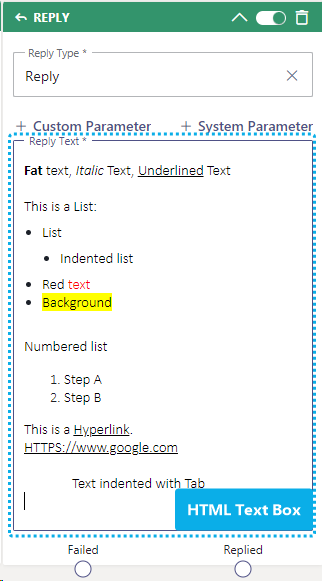 The HTML Text box supports:
Unsupported are layout-breaking elements such as:
|
Activity Exits
This activity has two exits that will correspond to folders in the originating Mailboxes:
-
Failed: If the activity failed this indicates underlying problems with the mailbox. The activity itself will be treated as ignored.
✅We recommend to Disconnect after the Failed exit to logically conclude the session. If you are using the Nimbus Power BI Template you can cross-check with the Nimbus Reporting Model > Service Session > “Service session Outcomes” > “Workflow Disconnect” as it could indicate issues on a particular service or mailbox. -
Replied: Exit taken when the mail reply has been successfully sent.
✅We recommend to follow up with “Mark as Handled”, “Queue” or “Disconnect” activity.
Save to Parameter
Save to Parameter
 Save to Parameter
Save to Parameter
| Description |
Allows to store Nimbus System Fields and Parameters and/or text into a Custom Parameter of your choice. You can extend this scenario further by including external systems via our Microsoft Power Automate Connector. Refer to our How to use the "Save to Parameter" workflow activity for an example and our Power Automate Use Cases further creative inspiration. |
||||||
| Required Predecessor | None. Relies on call Trigger Events to provide fields with actual content. | ||||||
| License |
|
||||||
| Modalities | Audio / Video | Instant Messaging | External Task | ||||
Common Properties
| Configurable Properties | Description |
|---|---|
| Parameter |
The Parameter of your choice to store a value in. 🔍 Availabiltiy of parameters in the selection depends on the Organization Unit of your current workflow. Note that parameters can have a default value that is overwritten once this activity is reached. |
| Value | A multiline textbox. Contents will be stored in your selected Parameter. TIPSYou can store a combined value of both Custom Parameters and/or System Fields and Parameters. To form complex validation chains you can combine "Save to Paramater" with previous data handling activities. For example:
KNOWN LIMITATION: The values stored in "Save to Parameter" are text-type only. Any relation to previous variables and parameter names to create this saved output is lost after exiting this activity. We are aware that having dynamic nested parameters in other activities would be very useful and are working to extend this functionality with future updates. |
Audio / Video
INC WF Properties remark
No specific behaviors for this modality. “Common Properties” apply.
Instant Messaging
INC WF Properties remark
No specific behaviors for this modality. “Common Properties” apply.
INC WF Properties remark
No specific behaviors for this modality. “Common Properties” apply.
External Task
INC WF Properties remark
No specific behaviors for this modality. “Common Properties” apply.
Standby Duty
Standby Duty
 Standby Duty
Standby Duty
INC Beta Feature

This feature is in PREVIEW and may not yet be available to all customers. Functionality, scope and design may change considerably.
| Description | Allows you to handle incoming calls outside of working hours by defining a list of standby duty numbers to be called. | ||||||
| Required Predecessor | Accept | ||||||
| License |
|
||||||
| Modalities | Audio / Video | Instant Messaging | External Task | ||||
Common Properties
| Configurable Properties | Description |
|---|---|
| Destination Type |
|
| Destination List / Custom Parameter |
|
| RONA Timeout |
Specifies the time the system uses to ring a phone number from the specified list (Destination List or Custom Parameter), then switches to the next phone number in the list.
|
| Max Attempt Cycles | Defines the number of times going through the list of phone numbers (Destination List or Custom Parameter) until one destination accepts the call by confirming. |
| Resource Type |
|
| Playlist/Resource |
Sets a waiting playlist / audio resource for to the caller while in queue. 🔍 Playlists and Resources (music) can be added and defined in Configuration. |
| Confirmation | Description |
| Prompt Type |
🔍 Audio resources can be added via Configuration > Resources . |
| Add Parameters | When enabled, parameters can be added and used in the prompt text. |
| Prompt Language | Allows to select the locale/voice to use when using the Text-to-Speech engine. |
| Prompt Text |
Allows you to add text that will be read in the prompt language/locale for the called standby duty contact. To make use of the functionality, Add Parameters need to be enabled first. Once enabled, you can add custom and system parameters to your prompt text |
| Resource | ✅ Only shown when "Prompt Type" = Resource is selected. |
| Confirmation DTMF | The confirmation that the called standby duty can make with a DTMF tone. |
| Confirmation During Announcement |
|
| Limit Confirmation Timeout |
|
|
Confirmation Timeout hh:mm:ss |
Max waiting time for confirmation.
|
Audio / Video
INC WF Properties remark
No specific behaviors for this modality. “Common Properties” apply.
Transfer
Transfer
 Transfer
Transfer
| Description |
Transfers the task to another service, user (within same tenant) or target SIP-address.
|
||||||
| Required Predecessor | Accept | ||||||
| License |
|
||||||
| Modalities | Audio / Video | Instant Messaging | External Task | ||||
Common Properties
| Configurable Properties | Description | ||||||||||
|---|---|---|---|---|---|---|---|---|---|---|---|
| Target | Allows you to define a transfer destination. The target choices and behavior depends on the Modalities set in your Service workflow. Please refer to the other tabs for further tips and limitations. Depending on modality, the choices of this parameter are:
Target Validity Checks💡 Please note that this activity does not perform target validity checks. Values must be well-formatted. ⮑ In case of an unknown or wrongly formatted target – including UPN / PSTN number format incorrectness – the "Failed" exit is taken. Show me how to verify thisTo ensure your transfer is done correctly, precede with a "Check Parameter" step depending on what scenario you expect in the parameter content:
🔎Here are some examples of Regular Expressions you can use. |
||||||||||
| Leave Nimbus | ✅Available if the target is External or any O365 user.
"LEAVE NIMBUS" ON EXTERNAL TRANSFERThis option has the following behavior for external transfers:
|
||||||||||
|
Timeout (hh:mm:ss, max 00:00:55) |
✅ Available if the target is a user or parameter. When the timeout criteria is met, the transfer is aborted ("Failed" exit is taken). |
||||||||||
| Waiting Music |
Allows to choose a playlist (default) or a single resource to play. 🔍 Playlists and Resources can be uploaded and defined within the Configuration.
|
||||||||||
Transfer Task Results
Transfer task results – used for Nimbus KPI Calculations and the Reporting service / user task model – can depend on the following transcripts:
Show details...
Transcripts |
Description |
Transfer Task considered as handled |
|---|---|---|
| Customer Hangup Before Accept | Customer hung up the call before it was accepted | ❌False |
| Customer Hangup In IVR Customer Hangup In IVR after queue |
Customer hung up the call before it was put into the queue once | ❌ False |
| Customer Hangup In Queue | Customer hang up the call during the time the task was enqueued | ❌ False |
| User Accepted | User accepted the task and was connected to the customer | ✅ True |
| User Internal Transfer Success | User accepted the task and transferred it to another service Line or user | ✅ True |
| User External Transfer Success | User accepts the task and transferred to a non service line or user | ✅ True |
| Workflow Disconnect After Queue Workflow Disconnect System Failure |
Workflow terminates the call after it was put once into the queue Workflow terminates the call, which was never put into the queue Something went really bad, including Microsoft infrastructure outage |
❌ False ❌ False ❌ False |
| Workflow Conversation Recorded | Workflow recorded a voice message / mail | ✅ True |
| Workflow Internal Transfer Successful | Workflow transferred the call to another Service Line Successful | ✅ True |
| Workflow Internal Transfer Failed | Workflow couldn't transfer the call to another Service Line | ❌ False |
| Workflow External Transfer Successful | Workflow transferred the call successful to a non service line target | ✅ True |
| Workflow External Transfer Failed | Workflow couldn't transfer the call to a non Service Line target | ❌ False |
Audio / Video
| Configurable Properties | Description | |||||||||||||||||||||||||||||||||||||||||||||||||||||||||||||||||||||||||
|---|---|---|---|---|---|---|---|---|---|---|---|---|---|---|---|---|---|---|---|---|---|---|---|---|---|---|---|---|---|---|---|---|---|---|---|---|---|---|---|---|---|---|---|---|---|---|---|---|---|---|---|---|---|---|---|---|---|---|---|---|---|---|---|---|---|---|---|---|---|---|---|---|---|---|
| Target | Allows you to define a transfer destination, with a choice between:
NOTES ON PSTN TRANSFERS
Transfer LimitationsTransfer to PSTN & LicensingINC Transfer to PSTN Limitation☝Nimbus and related addons can only perform PSTN transfers according to Microsoft's licensing and constraints. 🤔Which PSTN licenses do I need to acquire?Service Licensing
User Licensing
☝Please note that Luware staff cannot give recommendations on which license plan is best suited for your needs. Depending on your scenario, additional Teams App licenses may be required. Exact details are to be discussed with your Microsoft contacts. 🤔How does PSTN licensing affect Service and call transfers?Assuming that the initially called Service has (no) PSTN license assigned - the following scenarios may unfold: Scenario A - Service A has a PSTN license. Transfers to other Services occur. ⮑ The PSTN license carries over throughout transfers to other Nimbus Services B and C. Scenario B - Service B has no PSTN license. A Transfer to Service C occurs which has a PSTN license. ⮑ The customer skips over Service A and manages to reach Service B instead.  🌟Learnings:
✅ For your licensing needs this means: If you require PSTN transfer functionality, you'll need to ensure that this Service is handling all your incoming calls.
1🔎 Assumption: Workflow takes the normal “Exit” Announcement route and Service Session will conclude with a “Transfer failed” outcome. For more details on analyzing your Reporting results, refer to Nimbus Reporting and Static Dimensions > "Service Session Outcomes" ☝Note that handling and tracking of running cost for PSTN licenses is outside of the Luware support scope. If you however require assistance in extending and/or configuring your Nimbus Services for PSTN, our support will gladly assist you: Luware Support Address
Auto Attendant and Call QueuesINC Transfer to Teams Auto Attendant and Call Queues Limitation☝Out of box, transfers towards the UPNs of Teams-native Auto Attendants (AA) or Call Queues (CQ) Resource Accounts will fail. Preconditions and Workarounds apply.
Connectivity plan dependenciesBased on the PSTN connectivity option used, transfers towards the Resource Accounts' assigned phone numbers will work as summarized in the table below.
Federated transfersFederated transfers to users in another tenant are currently not supported. |
|||||||||||||||||||||||||||||||||||||||||||||||||||||||||||||||||||||||||
| Leave Nimbus | ✅ Available if the target is external or any O365 user.
"LEAVE NIMBUS" ON EXTERNAL TRANSFERThis option has the following behavior for external transfers:
|
|||||||||||||||||||||||||||||||||||||||||||||||||||||||||||||||||||||||||
| Transfer to Voicemail | ✅ Available when the target is a MS Teams user and "Leave Nimbus" is enabled:
☝No voicemail feature “Check-ahead”Currently there is no way to check ahead if a (target) user has voicemail features enabled.
No workaround: This is a design limitation by Microsoft which Nimbus currently cannot circumvent. Additionally the voicemail feature may also be deactivated as tenant-wide IT policy by your administrator. There are also known cases where Microsoft accepts transfers to voicemail but the recipient has no means to check (e.g. MS Teams Client / License restrictions). → We highly recommend using this feature ONLY in cases where you can ensure that voicemail is enabled for the Microsoft Teams user being transferred to. |
|||||||||||||||||||||||||||||||||||||||||||||||||||||||||||||||||||||||||
|
Timeout (hh:mm:ss, max. 00:00:55) |
✅ Available if the target is a user or parameter. When the timeout criteria is met, the transfer is aborted (the "Failed" exit is taken). |
|||||||||||||||||||||||||||||||||||||||||||||||||||||||||||||||||||||||||
| Waiting Music |
Allows to choose a playlist (default) or a single resource to play
🔍 Playlists and Resources can be uploaded and defined within the Configuration.
|
|||||||||||||||||||||||||||||||||||||||||||||||||||||||||||||||||||||||||
Instant Messaging
✅ Target Service Modalities Service Settings dependency:
- Only Services with Instant Messaging modality enabled in their Modalities Service Settings are selectable in this list.
- If a Service has the Instant Messaging modality not activated (anymore), the "Failed" exit is taken.
- In case of a deactivated required modality on the service, a warning is shown on the entry.
| Configurable Properties | Description |
|---|---|
| Target | Allows you to transfer an Instant Messaging session to other Nimbus services. |
| Leave Nimbus | Not applicable. |
| Transfer to Voicemail | Not applicable. |
|
Timeout (hh:mm:ss) |
Not applicable. |
| Waiting Music | Not applicable. |
External Task
✅ Target Service Modalities Service Settings dependency:
- Only Services with External Task modality enabled in their Modalities Service Settings are selectable in this list.
- If a Service has the External Task modality not activated (anymore), the "Failed" exit is taken.
- In case of a deactivated required modality on the service, a warning is shown on the entry.
| Configurable Properties | Description |
|---|---|
| Target | Allows you to transfer an External Task to other Nimbus services. 🔍 Microsoft Power Automate Connector - External tasks can be identified by Service Session ID as well as Unified Session ID, and deleted via " RemoveExternalTask" Flow Action. |
| Leave Nimbus | Not applicable. |
| Transfer to Voicemail | Not applicable. |
|
Timeout (hh:mm:ss) |
Not applicable. |
| Waiting Music | Not applicable. |
Voice Message
Voice Message
 Voice Message
Voice Message
| Description |
Allows the caller to record a voice message. Exits when the maximum recording time is reached. 🔎 Within the Nimbus Reporting Model this is tracked as Static Dimension > Service Session > “Workflow Conversation Recorded”. Licensing Note: The Voice Message feature is only available for MS-Teams based Service Types with Advanced Routing or Enterprise Routing license. These services can have a dedicated channel for posting Adaptive Cards, specified in the service's Modalities Service Settings.
The Voice Message feature is not available for cross-team Contact Center services, as no single MS Teams channel can be attributed for clear permission-handling of (potentially highly data-sensitive) recorded messages.
🔎 If you need more control over your recordings, including data retention and historic tracking, visit our Compliance Recording solutions page for more details. |
||||||
| Required Predecessor | Accept | ||||||
| License |
|
||||||
| Modalities | Audio / Video | Instant Messaging | External Task | ||||
Common Properties
| Configurable Properties | Description |
|---|---|
|
Play Recording Tone (toggle) |
Plays a beep tone. 💡 First action if this activity is reached. |
|
Maximum Recording time (hh:mm:ss) |
Starts the recording for the configured time span. Maximum 2 min. Afterwards the call is terminated. 💡 A caller has the chance to terminate the conversation earlier. |
| Message | Will send a message to the service chat channel within MS Teams. Example Message: 🔍 The content can also be with Custom Parameters or System Fields and Parameters, like: |
| +System / Custom Parameter | Allows the use of custom Custom Parameters and System Parameters, in the message field. |
Interactions with Power Automate Flows
When involving Nimbus Power Automate Connector, Trigger Events related to this workflow need to occur before the Voice Message Adaptive Cards is posted. Trigger Events cause the Flow Actions to execute and update your Custom Parameters.
Both Custom and System Parameters are replaced with actual data once the workflow activity is executed.
Interactions with Adaptive Cards
Once the "Voice Message" activity is finished:
- An Adaptive Card is sent to the Teams Channel with the Message and the recorded Audio File being directly accessible.

- SIP and phone parameters are added with a hyperlink.
By default the message state is: "New". This status updates according to the actions from any of your service users:
- Any service user an set from the status from “New” or “Solved” to "Listened" . → A message "Listened by <name>" is added.
- Any service user can set the message to "Solved". → The message is set to "Listened" and a message "Solved by <name>" is added.
Audio / Video
INC WF Properties remark
No specific behaviors for this modality. “Common Properties” apply.
Web Request
Web Request (Workflow Activity)
Web Request
| Description | Allows the configuration of HTTP requests and sending them within a workflow, without needing Power Automate. | ||||||
| Required Predecessor | None | ||||||
| License |
|
||||||
| Modalities | Audio / Video | Instant Messaging | External Task | ||||
Common Properties
| Configurable Properties | Description |
|---|---|
| Web Request | Allows you to select one of the preconfigured Web Requests. |
| Node Exits |
|
Audio / Video
INC WF Properties remark
No specific behaviors for this modality. “Common Properties” apply.
Instant Messaging
INC WF Properties remark
No specific behaviors for this modality. “Common Properties” apply.
INC WF Properties remark
No specific behaviors for this modality. “Common Properties” apply.
External Task
INC WF Properties remark
No specific behaviors for this modality. “Common Properties” apply.
Check
Check Activities
This page lists all Workflow activities that checking on an existing service status, e.g. by service queue availability or Opening Hours, queue position, or based on a previously stored Parameter values.
💡Note that activities below are listed in alphabetical order, which is not necessarily the order of their intended use.
Availability-based Routing
Availability-based Routing
 Availability-based Routing
Availability-based Routing
| Description |
Allows to route the call based on overall Service availability, considering MS Teams Presence – and in extension the Nimbus User State of all relevant Service Users. 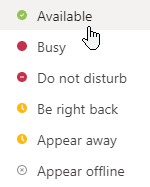 |
||||||
| Required Predecessor | None - can work even without accepting a call (e.g. to check ahead, then Accept, Transfer or Disconnect immediately) | ||||||
| License |
|
||||||
| Modalities | Audio / Video | Instant Messaging | External Task | ||||
Common Properties
| Configurable Properties | Description | |||||||||||||||||||||
|---|---|---|---|---|---|---|---|---|---|---|---|---|---|---|---|---|---|---|---|---|---|---|
| Service | Allows to select the target Service (within your tenant) for which the availability check and routing is performed for. 💡Usage notes:
|
|||||||||||||||||||||
|
Current Availability (Exit conditions) |
The activity has 3 exits based on the current overall team status (look-ahead). The availability depends on the User assignment type of your Service. 🤔 How can I determine the User Assignment Type?INC User Assignment TypesEach Nimbus Service can be of a different User Assignment Type that determines how Users are associated to this Service:
☝ Important to know: The User Assignment Type setting is fixated when a Service was either provisioned via MS Teams or manually created via Service Administration, e.g. either for Customer IVR or User skill-based task distribution purposes. A switch between MS Teams-based and Skill-based Services is not possible due to how individual Users are configured and how related Nimbus Features operate. Team owners can access Distribution Service Settings and inspect the "User Assignment Type". INC Service availability legend
|
|||||||||||||||||||||
Audio / Video
|
Current Availability (Exit conditions) |
Precondition: Task Parallelization is enabled for at least 1 user in the Service. With preconditions met, the Service availability changes as follows:
|
|||||||||
Instant Messaging
|
Current Availability (Exit conditions) |
Precondition: Task Parallelization is enabled for at least 1 user in the Service. With preconditions met, the Service availability changes as follows:
|
||||||
|
Current Availability (Exit conditions) |
Precondition: Task Parallelization is enabled for at least 1 user in the Service. With preconditions met, the Service availability changes as follows:
|
||||||
External Task
|
Current Availability (Exit conditions) |
Precondition: Task Parallelization is enabled for at least 1 user in the Service. With preconditions met, the Service availability changes as follows:
|
||||||
Check Opening Hours
Check Opening Hours
 Check Opening Hours
Check Opening Hours
| Description | Performs a check on the current Opening Hours calendar applied to the service and exits accordingly. | ||||||
| Required Predecessor | None - can work even without accepting a call (e.g. to Transfer to Service, Accept Conversation or Disconnect Conversation immediately) | ||||||
| License |
|
||||||
| Modalities | Audio / Video | Instant Messaging | External Task | ||||
Common Properties
| Configurable Properties | Description | |||||||||||||||||||||||||||||||||||||||||||
|---|---|---|---|---|---|---|---|---|---|---|---|---|---|---|---|---|---|---|---|---|---|---|---|---|---|---|---|---|---|---|---|---|---|---|---|---|---|---|---|---|---|---|---|---|
None |
Will exit based on currently active Opening Hour rule currently in effect for your General Service Settings.
🔍 Notes on Opening Hours:
Click here to learn more…Opening HoursOpening Hours are defined to reroute calls within your Workflows according to the hours / time zone at which customers call your service. Their configuration determines a caller routing experience as follows.
☝ IMPORTANT LEARNINGS
✅ Make sure to read the chapters below to understand opening hours in full detail. Understanding Active / Primary / Secondary HoursEach team may decide if the opening hours are applied as primary or secondary calendars within their General Service Settings . RULESET: PRIMARY AND SECONDARY OPENING HOURS
Creating Opening HoursNew Opening Hours can be defined from within Configuration either by Service Owners or Admins. Within the Nimbus UI:
 Calendar UI ElementsAn Opening Hours calendar consists of the following elements: 
RULESET: CALENDAR PERIOD OVERLAP🤔 What happens when there are multiple periods configured for the same time? If you have configured overlapping time periods with different types, then Nimbus will use the following order of precedence to determine which type applies:
💡 When multiple calendars overlap each other, the primary defined period takes precedence. See → Primary and Secondary hours chapter above. 💡 Your team's Workflow determines how the calls are handled as per currently valid period type, e.g., by playing an announcement during "Special" opening hours or routing the calls to other services during a holiday. Editing CalendarsTo define a new time period in your Opening Hours:
Putting your Opening Hours to useYour opening hours need to be handled and applied before taking effect. The steps necessary will be covered below. Step 1 - Workflow Setup☝ Important: When using your new or existing opening hours, ensure to handle all exit cases of calendar events (open, closed, special, holiday, default) in your "Check Opening Hours" Workflow Activity. 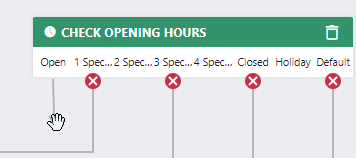 💡If no "Check Opening Hours" activity is defined in your workflow, the opening hours will be effectively ignored and your service is always reachable. Step 2 - Service SettingsFor your calendar to take effect you need to assign it on your service General Service Settings > Opening Hours. → After this assignment the opening hours will take effect immediately. Existing calls will still be handled according to the previous settings.  🔍Your currently applicable "Opening hours" are evaluated at the point of an incoming call. As the "Check Opening Hours" Activity is reached, one opening state is returned by Nimbus. It doesn't matter if a Primary, Secondary or no Opening Hours calendar was the source. This means that ...
💡As a general rule we recommend to handle all exits on your "Check Opening Hours" activity, even if they all point to an identicial (following) activity. Step 3 - Consider Impacts: Other Services, Reachability, KPI☝ As you make new Opening Hours calendars availabe in your Tenant – e.g. by placing them in high level Organization Units – please keep in mind:
Check before you edit existing (productive, shared) calendars☝ When your calendar is already in productive use, note that saved changes will take effect immediately upon the next incoming service task. → Make sure to take necessary precautions:

☝ General recommendation: The safe bet is to handle all exits on your workflow activity, as you you may lose tasks otherwise. 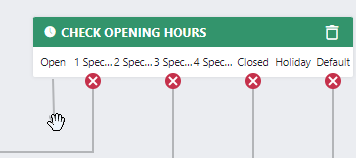 |
|||||||||||||||||||||||||||||||||||||||||||
Audio / Video
INC WF Properties remark
No specific behaviors for this modality. “Common Properties” apply.
Instant Messaging
INC WF Properties remark
No specific behaviors for this modality. “Common Properties” apply.
INC WF Properties remark
No specific behaviors for this modality. “Common Properties” apply.
External Task
INC WF Properties remark
No specific behaviors for this modality. “Common Properties” apply.
Check Parameter
Check Parameter
 Check Parameter
Check Parameter
| Description | Allows to check and react on system Fields and custom Parameters. | ||||||
| Required Predecessor | None - responds to parameters updated during Trigger Events. | ||||||
| License |
|
||||||
| Modalities | Audio / Video | Instant Messaging | External Task | ||||
Common Properties
| Configurable Properties | Description |
|---|---|
| Parameter Type | Offers a choice between:
|
| Custom Type |
🔍 Dependent on the "parameter type" selected:
|
| Name |
✅ Only shown when "parameter type" = Custom is selected. Allows you to define the a name used for the parameter. This name must match the dynamic value when using the Nimbus Power Automate Connector. |
Checks (Regex Validation)
Allows to define one or many Regular Expressions checks on the "parameter type / name" chosen above.
☝ Checks will be performed in your defined order. The first valid check will determine the activity exit. Any further matching expressions are ignored.
Regular Expressions cannot be empty. By default ".*" will allow anything as a parameter content = Parameter is present.
Parameter values are treated case-insensitive (ignoring capitalization) during validation and comparison for the “CheckParameter” workflow activity (e.g., "UserID", "userid", "USERid" are all treated the same).
| No Match | Taken when none of the provided Regular Expressions matches. |
| Not Set |
Taken when either criteria applies:
|
| Check 1.....n |
Check if the value of the parameter matches one of the Regex validations. 💡 By default 1 "Check 1" exit is defined and required. Up to 10 can be defined each with individual node exits.
The following criteria applies:
|
💡Tip: If you need to handle more parameters, You can also chain several "Check Parameter" activities.
Audio / Video
INC WF Properties remark
No specific behaviors for this modality. “Common Properties” apply.
Instant Messaging
INC WF Properties remark
No specific behaviors for this modality. “Common Properties” apply.
INC WF Properties remark
No specific behaviors for this modality. “Common Properties” apply.
External Task
INC WF Properties remark
No specific behaviors for this modality. “Common Properties” apply.
Get Available Users
Get Available Users
 Get Available Users
Get Available Users
| Description | Performs a lookahead-check on the users / Agents available in a Nimbus service and stores the value in a Parameter. | ||||||
| Required Predecessor | None | ||||||
| License |
|
||||||
| Modalities | Audio / Video | Instant Messaging | External Task | ||||
Common Properties
| Configurable Properties | Description |
|---|---|
| Service | Can either be the "Current Service" – e.g. in workflows used by multiple services – or a specific service. |
| Custom Parameter | ✅ Requires at least one Parameter to be defined and available as selectable "placeholder" under the same Organization Unit (or higher up to Tenant level). 🔍 This activity stores output into a custom Parameter for processing, which can then be used within the same workflow (e.g. a " Check Parameter " activity). Note that the parameter's default value is being overwritten once it passes through this activity. Once this activity is reached, it checks the number of available users of the specified Service:
→ For more information, read our pages on Service Type and the according User assignment method. |
Audio / Video
INC WF Properties remark
No specific behaviors for this modality. “Common Properties” apply.
Instant Messaging
INC WF Properties remark
No specific behaviors for this modality. “Common Properties” apply.
INC WF Properties remark
No specific behaviors for this modality. “Common Properties” apply.
External Task
INC WF Properties remark
No specific behaviors for this modality. “Common Properties” apply.
Get Queue Position
Get Queue Position
 Get Queue Position
Get Queue Position
| Description | Performs a lookahead-check on the (potential) queue position in a Nimbus service and stores the value in a Parameter. | ||||||
| Required Predecessor | None - responds to parameters updated during Trigger Events. | ||||||
| License |
|
||||||
| Modalities | Audio / Video | Instant Messaging | External Task | ||||
Common Properties
| Configurable Properties | Description |
|---|---|
| Service | Can either be the "Current Service" for workflows commonly used by multiple services or a specific service. |
| Custom Parameter | ✅ Requires at least one Parameter to be defined and available as selectable "placeholder" under the same Organization Unit (or higher up to Tenant level). 🔍 This activity stores output into a custom Parameter for processing, which can then be used within the same workflow (e.g. a " Check Parameter " activity). Note that the parameter's default value is being overwritten once it passes through this activity. Once this activity is reached, it checks the number of available users of the specified Service
💡 By default this activity does not create a "visible" outcome. We recommend to follow up with a "Check Parameter" activity and route your customers according to the queue position value (e.g. add further announcement, voicemail, play music activities). |
INC Modality-independent queue length
🔎Design Note: Nimbus does not distinguish the queue length by modality.
Learn more…
💡Example: Let's assume there are 10 Audio/Video, 2 Emails and 1 Instant Messaging (IM) tasks in the queue.
Let's focus on the IM Task, which appeared most recently in the queue.
⮑ When querying the queue position of the IM task, the value returned will be 13.
⮑ When another task enters the queue - regardless of modality - it gets position 14.
With 2 users available to handle all modalities, this setup would work as planned, as every task gets treated equally. However there can be situations when your users can handle only certain modalities within a service that supports several or all modalities. This can create bottlenecks in the task distribution that Nimbus cannot anticipate.
🔎Analysis: For Nimbus, task modality does therefore not matter when retrieving the queue position. The IM Task on position 13 will move up the queue eventually over time, but may get stuck at position 1, as no user is available to handle the chat. Other modality tasks may get handled earlier – e.g. due to users being available that can handle that modality. Another case could be that other tasks (even in the same modality) have a higher Priority set.
🤔Why is it solved like that? The quick answer: simplicity and consistency. The Nimbus UI will always list all pending tasks in the queue equally, matching what “queue” related workflow activities will return. This is assuming the most-popular use case where all your users can handle all modalities.
However, in a use case scenario where users are specialized on handling certain modalities, estimating queue length would depend on additional factors such as…
- … the current availability of “modality-capable” users within your service.
- … being able to gauge the “average” task handling time.
→ Nimbus therefore delivers the actual, “more pessimistic” task position instead of making assumptions on potentially available users. This is done to not mislead customers with a positive queue position that may still result in long waiting times.
🤔How can I improve my queue estimate precision?
→ Most of our customers prefer using separate services per modality as “task silos”, which also leads to clearer task distribution to a dedicated user pool, separate Nimbus Reporting of sessions, dedicated access with Portal Roles and easier to manage KPI adjustments and other specific Service Settings.
→ If you do not want to split up your services, another approach could be to work with Task Priority by specifically targeting certain modality tasks with a higher or lower priority. This can be achieved with the Nimbus Power Automate Connector.
→ You can also use the Nimbus Power BI Template and OData Feed to draw data and make adjustments to your workforce and service configuration.
Audio / Video
INC WF Properties remark
No specific behaviors for this modality. “Common Properties” apply.
Instant Messaging
INC WF Properties remark
No specific behaviors for this modality. “Common Properties” apply.
INC WF Properties remark
No specific behaviors for this modality. “Common Properties” apply.
External Task
INC WF Properties remark
No specific behaviors for this modality. “Common Properties” apply.
Origin Routing
Origin Routing
 Origin Routing
Origin Routing
| Description |
Allows to route incoming calls and tasks based on their origin. We generally recommend using the “Origin Routing” Workflow Activity to circumvent parts of workflows only meant for outside customers. The goal is to shorten internal Consultation Call wait times, e.g. by using activities such as Task Priority, skipping inputs, or leading the callers directly into the queue. |
||||||
| Required Predecessor | Accept | ||||||
| License |
|
||||||
| Modalities | Audio/Video | Instant Messaging | External Task | ||||
Common Properties
| Properties | Description |
|---|---|
|
Origin Routing (Exit conditions) |
This activity offers two exits:
|
1🔎Consultation Call Limitations
INC Consultation Call Limitations
KNOWN CONSULTATION LIMITATIONS
INC Preview Feature

This feature is in PREVIEW and may not yet be available to all customers. Functionality, scope and design may change considerably.
☝As this feature is still in preview stage, please carefully read the limitations below:
☝Consultation Call to Service limitations
- Because of how MS Teams handles certain call scenarios in a conference scenario, support for Workflow Activities is currently limited. We are actively working on improvements to the currently unsupported workflow activities.
| ✅ Supported Workflow Activities | 🔜 Unsupported Workflow Activities |
|
|
|
❌ Out of scope (by design)
|
-
My Sessions call terminate: to terminate a call, the customer is removed from call. The consultant stays in the call.
→ Recommendation: Use Attendant Console or Assistant to terminate calls. -
Currently swapping and talking to the customer while waiting in Queue / IVR is not possible.
→ We generally recommend using the “Origin Routing” Workflow Activity to circumvent parts of workflows only meant for outside customer, e.g. pointing directly into the queue, using Task Priority and skipping inputs. - Supervision is not available during consultation to service.
- Users cannot consult to the PSTN of a service → Instead use the UPN (Name) of the service.
1 Rationale: As soon as the call is escalated to a group call, MS Teams is not forwarding DTMF tone events anymore. This is a technical limitation that cannot be circumvented by Nimbus.
☝Consultation Call to User limitations
- Lower reporting detail: When consulting with any users in your O365 directory (both Nimbus and not), the session reporting is not as detailed as when using a Consultation Call to Service.
- Incorrect status / Nimbus task blocking: Unless Use Case - Tracking Extended User Presence via Application Permission is implemented, Nimbus users are are not always correctly blocked by incoming consultation calls and do not receive ACW, as Nimbus cannot read the exact presence status in MS Teams.
- Supervision not available during consultation to user.
☝Consultation Call Reporting limitations
-
Nimbus Power BI Template missing KPI: Currently the
InitialCallerKPIs on Unified Sessions are not yet reflected in the BI template. This will be improved in a future template update. -
Facts > User Sessions: In conference scenarios, the
ConferencedTimeis not recorded for the first agent. -
Static Dimensions > Transfer Session: You may notice that some inaccuracies or gaps in reporting for consultation scenarios to a service occur and will remain visible in the long‑term data. We’re already working on improvements, and the upcoming versions of the report will reflect higher accuracy and stability.
- Outcome discrepancy on user session and service session level.
-
UserTransferActionTypestates "safe" although it should be “consultative”.
Audio / Video
INC WF Properties remark
No specific behaviors for this modality. “Common Properties” apply.
Instant Messaging
INC WF Properties remark
No specific behaviors for this modality. “Common Properties” apply.
INC WF Properties remark
No specific behaviors for this modality. “Common Properties” apply.
External Task
INC WF Properties remark
No specific behaviors for this modality. “Common Properties” apply.
Wait for Parameter
Wait for Parameter
 Wait for Parameter
Wait for Parameter
| Description | Adds a wait time to the workflow to allow external systems to update a previously defined Parameters. | ||||||
| Required Predecessor | None | ||||||
| License |
|
||||||
| Modalities | Audio / Video | Instant Messaging | External Task | ||||
Common Properties
✅ Condition: The Nimbus Power Automate Connector "Update Task" Flow Action needs to be involved for this activity to detect parameter changes.
💡Parameter Update Check: Upon entering the activity, a comparison against the default value of the Parameter is made:
- When the Parameter already differs from the default OR gets updated anywhere within the specified “Max Waiting Time”, the "Updated" exit is taken.
- When the "Max Waiting time" is reached, the "Timeout Reached" exit is taken, regardless of any (later) parameter updates.
- When the activity is disabled the "Max Wait time" will be ignored and the "Timeout Reached" exit is taken immediately upon reaching this activity.
☝ Note: Any change is considered as an update - without validation. A follow-up "Check Parameter" activity is therefore strongly recommended to validate the output with Regular Expressions.
| Configurable Properties | Description |
|---|---|
| Parameter Type | Currently locked to previously "Custom Parameters". To be defined and available as selectable "Custom Type" parameter. |
| Custom Type |
🔍 Dependent on the "parameter type" selected:
|
| Name |
✅ Only shown when "parameter type" = Custom is selected. Allows you to define the a name used for the parameter. This name must match the dynamic value when using the Nimbus Power Automate Connector. |
| Max Waiting Time |
Maximum wait time to
💡When "Max Wait time" is reached (or this activity is disabled), the "Timeout Reached" exit is taken. |
| Play Announcement (optional) |
Plays an announcement during the wait time. Default: disabled
☝Note: The announcement is not being played, if the parameter value already has been updated from its default. In this case the “Updated” exit is taken immediately, as there is no point in playing an announcement anymore. |
| Announcement Type |
✅ Audio resources can be added via Configuration > Resources |
|
Add Parameters (Toggle) |
Will allow the use of Custom Parameters and System Fields and Parameters in the "Prompt Text" Field.
💡 Note that with this option enabled the will "Preplay" feature is disabled as parameters are dynamically resolved during a call. |
| Prompt Language | Allows to select the locale / voice to use when using the Text-to-Speech engine. |
| Prompt Text | ✅ Only shown when Announcement Type = Text to Speech is selected.
|
Audio / Video
INC WF Properties remark
No specific behaviors for this modality. “Common Properties” apply.
Queue
Queue Activities
This page lists all Workflow activities that take influence on the Nimbus Service Task Queue and Distribution. Note that Distribution Service Settings of your services (e.g. Conversation Distribution, Task Priority, ACW, RONA) share dependencies with these activities.
💡Note that activities below are listed in alphabetical order, which is not necessarily the order of their intended use.
KNOWN LIMITATION
Several queues during the same session are not supported. If a task enters the queue once (with the Queue or the Queue Task activity), it can't enter it again. Using multiple Queue/Queue Task activities subsequently might therefore lead to undesirable behavior.
Cancel Task
Cancel Task
 Cancel Task
Cancel Task
| Description |
Cancels a pending task and all ongoing connection attempts. Usage Conditions:
|
||||||
| Required Predecessor | Accept → Queue Task (anywhere prior in the workflow) | ||||||
| License |
|
||||||
| Modalities | Audio / Video | Instant Messaging | External Task | ||||
Common Properties
| Configurable Properties | Description |
| None | ☝ Important: If the task is currently ongoing with an assigned user, the service task is marked as "Abandoned" in Reporting. |
Audio / Video
INC WF Properties remark
No specific behaviors for this modality. “Common Properties” apply.
Tip: Start with a Workflow Template
You can find a basic example on how to use “Queue, Check, Cancel Task” type activities by starting with our “Queue IVR Voicemail” Workflow Template.
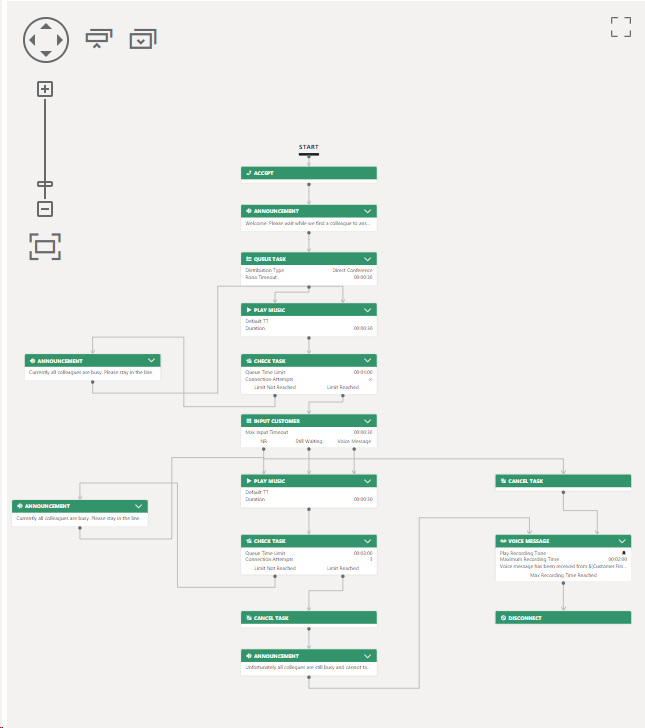
Instant Messaging
INC WF Properties remark
No specific behaviors for this modality. “Common Properties” apply.
INC WF Properties remark
No specific behaviors for this modality. “Common Properties” apply.
External Task
INC WF Properties remark
No specific behaviors for this modality. “Common Properties” apply.
Check Task
Check Task
 Check Task
Check Task
| Description |
Checks the current state of the task and takes exit paths accordingly. Usage Conditions:
|
||||||
| Required Predecessor | Accept → Queue Task (anywhere prior in the workflow) | ||||||
| License |
|
||||||
| Modalities | Audio / Video | Instant Messaging | External Task | ||||
Common Properties
| Configurable Properties | Description |
|
Queue Time Limit (dd:hh:mm:ss) |
Sets the allowed maximum time limit.
|
|
Connection Attempts (toggle) |
Enables an attempt check for this task. (Call ringing or Chat request to any user, counting the total attempts made). 🔍 Rules in the info box below apply. |
|
Connection Attempts (number) |
✅ Shown when attempts are enabled. Sets the amount of maximum connection attempts to users. |
Exit Criteria Rules
INC Modality-independent queue length🔎Design Note: Nimbus does not distinguish the queue length by modality. Learn more…💡Example: Let's assume there are 10 Audio/Video, 2 Emails and 1 Instant Messaging (IM) tasks in the queue. With 2 users available to handle all modalities, this setup would work as planned, as every task gets treated equally. However there can be situations when your users can handle only certain modalities within a service that supports several or all modalities. This can create bottlenecks in the task distribution that Nimbus cannot anticipate. 🔎Analysis: For Nimbus, task modality does therefore not matter when retrieving the queue position. The IM Task on position 13 will move up the queue eventually over time, but may get stuck at position 1, as no user is available to handle the chat. Other modality tasks may get handled earlier – e.g. due to users being available that can handle that modality. Another case could be that other tasks (even in the same modality) have a higher Priority set. 🤔Why is it solved like that? The quick answer: simplicity and consistency. The Nimbus UI will always list all pending tasks in the queue equally, matching what “queue” related workflow activities will return. This is assuming the most-popular use case where all your users can handle all modalities. However, in a use case scenario where users are specialized on handling certain modalities, estimating queue length would depend on additional factors such as…
→ Nimbus therefore delivers the actual, “more pessimistic” task position instead of making assumptions on potentially available users. This is done to not mislead customers with a positive queue position that may still result in long waiting times. 🤔How can I improve my queue estimate precision? → Most of our customers prefer using separate services per modality as “task silos”, which also leads to clearer task distribution to a dedicated user pool, separate Nimbus Reporting of sessions, dedicated access with Portal Roles and easier to manage KPI adjustments and other specific Service Settings. → If you do not want to split up your services, another approach could be to work with Task Priority by specifically targeting certain modality tasks with a higher or lower priority. This can be achieved with the Nimbus Power Automate Connector. → You can also use the Nimbus Power BI Template and OData Feed to draw data and make adjustments to your workforce and service configuration. | |
Audio / Video
INC WF Properties remark
No specific behaviors for this modality. “Common Properties” apply.
Tip: Start with a Workflow Template
Multiple “Check Task” activities can be used in a workflow, e.g. in between "Play Music", "Input Customer", "Get Queue Position".
You can find a basic example on how to use “Queue, Check, Cancel Task” type activities by starting with our “Queue IVR Voicemail” Workflow Template.

Instant Messaging
INC WF Properties remark
No specific behaviors for this modality. “Common Properties” apply.
INC WF Properties remark
No specific behaviors for this modality. “Common Properties” apply.
External Task
INC WF Properties remark
No specific behaviors for this modality. “Common Properties” apply.
Distribution Priority
Distribution Priority
 Distribution Priority
Distribution Priority
| Description |
This activity overrides the default "Task Priority" – by Default: Normal – configured in your within Distribution Service Settings > Task Priority section. Note: Flow Actions used in the Nimbus Power Automate Connector can also impact the “Task Priority” of an existing task, effectively overriding both default service settings and your workflow. |
||||||
| Required Predecessor | Accept | ||||||
| License |
|
||||||
| Modalities | Audio / Video | Instant Messaging | External Task | ||||
Common Properties
INC Distribution Priority
| Configurable Property | Description | Behavior |
| Priority |
* see notes below. |
|
When to select "Strict" or "Nothing Else" as priority?
☝ “Strict” tasks will always be put on top of your queue.
⮑Other tasks can get lost due to potentially long queue times as “Strict” tasks always take precedence.
✅ Use this for emergency services and important VIP hotlines that always should get precedence over anything else in your queue.
☝"Nothing Else" tasks will only get distributed when your service queue is empty.
⮑These tasks can get lost due to all other tasks taking precedence.
✅ Use this for non-time-sensitive tasks in when your maximum queue time is long enough for them to get handled.
Priority in other Nimbus areas
- Whenever certain workflow Trigger Event criteria are met, certain Flow Actions from the Nimbus Power Automate Connector can also be used to set a task priority dynamically. ⮑ This is overriding the default priority set in the Distribution Service Settings.
- In general, tasks are always distributed according to a service's Distribution Policy (e.g. among "Longest Idle" or "Most qualified" Nimbus users first). 💡 Priority does only affect WHEN a task gets distributed, the policy determins WHO receives it first.
- In all Nimbus views with a task list (e.g. My Overview or Personal Dashboards with "Task" widgets) a "Priority" column indicates how high this task is ranked in the queue. With this setting, tasks may now "displace" existing tasks to a new rank.
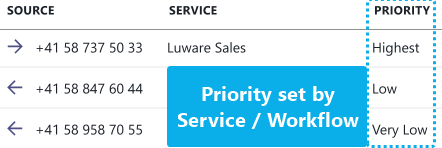
Weighted Round Robin Task Distribution
Due to priority-influencing factors mentioned above, tasks may starve long enough to drop out of your queue. An example would be a "Lowest" priority task getting outranked by a huge or stead inflow of higher priority tasks.
To avoid this, a weighted round robin method is in place to mix in lower-priority tasks, which are equally distributed amongst available users.
INC Weighted Round Robin Method
Learn more about the weighted round-robin method
The Round Robin procedure distributes the calls in such a way that the ratio between the individual priority levels is always 2:1. Each time another "Round" is started, that round counter is applied to the "weight" of the remaining tasks.
The following example table assumes a configuration with 3 priority levels. There are 21 calls in the queue, with the following priority:
- 12 calls with priority 1
- 6 calls with priority 2
- 3 calls with priority 3
Following the 2:1 rule, the calls are queue over time t as follows:
- Round 1: High Med tasks added in 2:1 ratio. No "Low" priority tasks in Round 1 as "Medium" task count outweighs the low task count.
- Round 2: High Med Low tasks added in 2:1 ratio. The "Low" priority tasks get a round-multiplier added to their weight, now outweighing "Medium" tasks and thus are added in a 2:1 ratio.
- Round 3: Same as Round 1.
🔍 Sources: Weighted Round Robin (Wikipedia Article). Please note that this example only works as long as no new calls are being processed. Calls with strict or no priority are not considered in this rule.
Legend: Q: Calls in Queue | H: Handled | R: Remaining
| Priority | Q | H | R | H | R | H | R | H | R | H | R | H | R | H | R | H | R | H | R | H | R | H | R | H | R | H | R | H | R | H | R |
|---|---|---|---|---|---|---|---|---|---|---|---|---|---|---|---|---|---|---|---|---|---|---|---|---|---|---|---|---|---|---|---|
| 1 (high) | 12 | 2 | 10 | 2 | 8 | 2 | 6 | 2 | 4 | 2 | 2 | 2 | 0 | ||||||||||||||||||
| 2 (med) | 6 | 1 | 5 | 1 | 4 | 1 | 3 | 1 | 2 | 1 | 1 | 1 | 0 | ||||||||||||||||||
| 3 (low) | 3 | 1 | 2 | 1 | 1 | 1 | 0 | ||||||||||||||||||||||||
| Round Counter | Round 1 | Round 2 | Round 3 | Round 4 | Round 5 | Round 6 | |||||||||||||||||||||||||
| Time (t) | t1 | tn | |||||||||||||||||||||||||||||
☝ Reminder: Tasks in a queue with either "Strict" or "Nothing Else" priority will ignore round-robin distribution.
Audio / Video
INC WF Properties remark
No specific behaviors for this modality. “Common Properties” apply.
Instant Messaging
INC WF Properties remark
No specific behaviors for this modality. “Common Properties” apply.
INC WF Properties remark
No specific behaviors for this modality. “Common Properties” apply.
External Task
INC WF Properties remark
No specific behaviors for this modality. “Common Properties” apply.
Queue
Queue
 Queue
Queue
| Description |
Puts a task into the queue for the dedicated service line. The “Queued” status lasts until either of the following activities is met:
The following user-side actions also end the task:
|
||||||
| Required Predecessor | Accept | ||||||
| License |
|
||||||
| Modalities | Audio / Video | Instant Messaging | External Task | ||||
Common Properties
| Configurable Properties | Description | ||||||||||||||||||
|---|---|---|---|---|---|---|---|---|---|---|---|---|---|---|---|---|---|---|---|
Distribution Type |
Distribution Types
💡Footnotes1 Depending on the modality used, certain “Distribution Type” settings may not be supported by certain Queue Activities in your Workflows.
|
||||||||||||||||||
|
Conditional Options (shown based on "Distribution Type") |
Description | ||||||||||||||||||
|
Adaptive Cards (toggle) |
✅ Requires a "Pickup" Distribution Type to be set. Enable this for Adaptive Cards to be created automatically within the Service chat channel in MS Teams. 🔍 Adaptive cards will update with the call information. Team members can also opt to pick up calls, listen to voice recordings or mark the call as handled within the card itself. |
||||||||||||||||||
|
RONA Timeout (default / max 00:00:55) |
Specifies the time the system uses to ring a service user, then switches to the next available user in the queue. Applies a RONA status flag when the timeout for the current "Queue" Activity is reached. 💡This setting relies on "Distribution Type" chosen. If not available the RONA timeout is either hardcoded (field greyed out) or the "Calling / Queue Timeout" settings apply instead. Also refer to "Distribution Type" above for more info on RONA. 💡RONA status will not apply to "Broadcast" distribution type setting. INC Outbound Ring Time LimitationRING TIME LIMITATIONMicrosoft can terminate the dial out in ~35 seconds for some tenants.
|
||||||||||||||||||
|
Max Queue Timeout (dd:hh:mm:ss, default 00:00:01:00) |
Waits for the specified time, then uses the "Max Queue Timeout Reached" exit node.
|
||||||||||||||||||
| Playlist |
Sets a waiting playlist for to the caller while in queue. 🔍 Playlists and Resources (music) can be added and defined in the Configuration. |
Audio / Video
INC WF Properties remark
No specific behaviors for this modality. “Common Properties” apply.
| Configurable Properties | Description |
|---|---|
Distribution Type |
Only “Direct distribution” is available |
|
Adaptive Cards (toggle) |
Not available. |
|
RONA Timeout (default / max 00:00:55) |
Specifies the time the system uses to ring a service user, then switches to the next available user in the queue. Applies a RONA status flag when the timeout for the current "Queue" Activity is reached. |
|
Max Queue Timeout (default 00:01:00) |
Waits for the specified time, then uses the "Max Queue Timeout Reached" exit node. |
| Playlist | Not available. |
External Task
| Configurable Properties | Description |
|---|---|
Distribution Type |
Only “Direct distribution” is available |
|
Adaptive Cards (toggle) |
Not available. |
|
RONA Timeout (default / max 00:00:55) |
Specifies the time the system uses to ring a service user, then switches to the next available user in the queue. Applies a RONA status flag when the timeout for the current "Queue" Activity is reached. |
|
Max Queue Timeout (default 00:01:00) |
Waits for the specified time, then uses the "Max Queue Timeout Reached" exit node. |
| Playlist | Not available. |
Queue Task
Queue Task
 Queue Task
Queue Task
| Description |
Puts a task into the queue for the dedicated service line. The customer will hear wait music. 🤔 Why pick this over the "Queue" activity?
The default "Queue" activity will simply wait until the end criteria is met. “Queue Task” allows for further interactions when paired with "Check Task" and "Cancel Task". Learn more…Depending on your chosen modality you can get a much more sophisticated workflow in place. For example:
The following user-side actions also end the task:
Usage Conditions:
|
||||||
| Required Predecessor | Accept | ||||||
| License |
|
||||||
| Modalities | Audio / Video | Instant Messaging | External Task | ||||
Common Properties
| Configurable Properties | Description | ||||||||||||||||||
|---|---|---|---|---|---|---|---|---|---|---|---|---|---|---|---|---|---|---|---|
Distribution Type |
Distribution Types
💡Footnotes1 Depending on the modality used, certain “Distribution Type” settings may not be supported by certain Queue Activities in your Workflows.
|
||||||||||||||||||
|
Conditional Options (shown based on "Distribution Type") |
Description | ||||||||||||||||||
|
Adaptive Cards (toggle) |
✅ Requires a "Pickup" Distribution Type to be set. Enable this for Adaptive Cards to be created automatically within the Service chat channel in MS Teams. 🔍 Adaptive cards will update with the call information. Team members can also opt to pick up calls, listen to voice recordings or mark the call as handled within the card itself. |
||||||||||||||||||
|
RONA Timeout (default / max 00:00:55) |
Specifies the time the system uses to ring a service user, then switches to the next available user in the queue. Applies a RONA status flag when the timeout for the current "Queue" Activity is reached. 💡This setting relies on "Distribution Type" chosen. If not available the RONA timeout is either hard-coded (field greyed-out) or the "Calling / Queue Timeout" settings apply instead. → Also refer to "Distribution Type" above for more info on RONA. 💡RONA status will not apply to "Broadcast" distribution type setting. INC Outbound Ring Time LimitationRING TIME LIMITATIONMicrosoft can terminate the dial out in ~35 seconds for some tenants.
|
Audio / Video
INC WF Properties remark
No specific behaviors for this modality. “Common Properties” apply.
Tip: Workflow Template
Start with our “Queue IVR Voicemail” Workflow Template to learn how “Queue, Check, Cancel Task” activities can be used.

Instant Messaging
| Configurable Properties | Description |
|---|---|
Distribution Type |
Only “Direct distribution” is available |
|
Adaptive Cards (toggle) |
Not available. |
|
RONA Timeout (default / max 00:00:55) |
Specifies the time the system uses to ring a service user, then switches to the next available user in the queue. Applies a RONA status flag when the timeout for the current "Queue" Activity is reached. |
| Configurable Properties | Description |
|---|---|
Distribution Type |
Only “Direct distribution” is available |
|
Adaptive Cards (toggle) |
Not available. |
|
RONA Timeout (default / max 00:00:55) |
Specifies the time the system uses to ring a service user, then switches to the next available user in the queue. Applies a RONA status flag when the timeout for the current "Queue" Activity is reached. |
External Task
| Configurable Properties | Description |
|---|---|
Distribution Type |
Only “Direct distribution” is available |
|
Adaptive Cards (toggle) |
Not available. |
|
RONA Timeout (default / max 00:00:55) |
Specifies the time the system uses to ring a service user, then switches to the next available user in the queue. Applies a RONA status flag when the timeout for the current "Queue" Activity is reached. |
Workflow Troubleshooting
Avoiding Workflow Issues
☝ The workflow editor is a very powerful tool, but also allows for misconfigurations and lost calls. Listed below are the most common issues our users report, and how to avoid them:
✅ Workflows: Best Practice
- Make sure to use Workflow Templates as pointers on how your workflows should be structured. Gradually expand and test your configurations to avoid mistakes.
- We provide Power Automate Use Cases examples that also include examples using the workflow editor. Read them to get the most out of Nimbus and your external systems.
- Keep in mind that any workflow changes take effect immediately – either in Modalities Service Settings or the workflow itself. We therefore recommend to test larger changes on copies or a (hidden) service, using test calls.
| Issue | Caused by | How to Avoid |
|---|---|---|
| 🤔 Calls are not getting accepted at all | "Start" node wasn't connected to any other Workflow Activity node. |
|
| 🤔 Calls are accepted but not handled (to completion) | Announcements or similar activities have exit nodes which are not handled, resulting in stuck calls. |
|
| 🤔 Calls are stuck in an infinite loop | Steps redirecting on themselves with no exit condition. |
|
| 🤔 Calls were not re-entered in the same Queue |
Calls reaching the end of a Queue e.g. "Timeout" getting re-inserted into the same queue. This causes inconsistent reporting states for the call and sometimes Infinite loops. |
|
| 🤔Parameter checks fail or the default exit is always taken | Either the parameter is not written correctly (or not in time) or the validation with regular expression fails to find a pattern. In either case the workflow activity takes the default exits. |
|
| 🤔I want to select a certain Configuration data item but don't see it in my workflow |
Visibility data entities in your workflows follows the Organization Unit (OU) → "Reading along the path" rule.
When workflow-dependent items are moved to a different OU, your workflow will continue to operate. However, once deselected away from, a moved entity cannot be selected again. |
|


